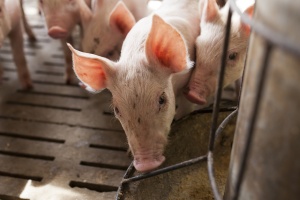5 Things GMOs Aren’t
A year ago, I didn’t even know what a GMO was.
On our spring Field Mom tour of Jeschke Farms, a 4,000 acre corn and soybean farm in Mazon, Illinois, we learned about biotechnology. It was explained to us in a positive light; they shared the benefits of biotechnology and also gave us resources where we could go to learn more.
I’ve come a long way in my understanding of biotechnology in the past few months, but I have a lot more to learn. While I’ve done a lot of reading on my own, most of the information in this post has come from the Illinois Farm Families and the resources they’ve shared. The resources are rooted in science and trust in our regulating bodies (USDA/FDA/EPA, as well as global partners in science).
1. GMOs aren’t…
…simple science. Biotechnology is sophisticated and it is abstract. We can’t touch it or see it first-hand. Most ordinary folks, like me, may find biotechnology difficult to understand. As we read food biotech articles written by journalists, we need to keep in mind that they were probably not students of science, and are paid to do some research and write on the topic. Their information is only as good as their research. Biotech scientists are not paid to write for us. They spend their time “doing” the science and not talking about it. I like the GMO Answers website because scientists are answering some of our questions in plain English.
2. GMOs aren’t…
…the invention of Monsanto. Monsanto is a single company who is capitalizing on biotechnology and enjoys a significant market-share of 20 to 30 percent of the seed industry. GMOs did not originate there and Monsanto is not the be-all and end-all of biotechnology. Monsanto is not involved with all types of crops, nor are they the only research company. There are many other biotech seed companies, such as Dupont, Syngenta, and Bayer Crop Science. Illinois Farm Moms have made a point to tell us that they have many seed companies to choose from, about 150 U.S. companies, in fact. There is a great question and answer on GMO Answers about large versus small biotech firms. There are many small biotech companies and even universities, like Cornell University, creating GMOs.
3. GMOs aren’t…
…just about killing bugs and weeds. Food biotechnology is also about plant disease-resistance. The Hawaiian papaya industry was saved in 1998 by a GMO created at Cornell University that was resistant to a devastating plant virus. The Florida citrus industry is currently in danger of collapse from a virus and, similar to the Hawaiian Papaya, biotechnology may be the only long-term solution. The GMO is years from approval, but since it is a genetically-engineered solution, it will likely hang in the balance of consumer opinion. In addition to disease resistance, there are real opportunities to create plant traits with drought tolerance, nitrogen-use efficiency, and nutritional improvement. Imagine the effect on the environment of crops that use significantly less water, our most precious natural resource, or that require less nitrogen. Golden Rice is an example of how a GMO could improve human health. Millions of children in undeveloped nations are vitamin A deficient, which causes blindness and death. Rice, their staple food, could provide them with more of the nutrients they need. A new type of soybean has been planted in the U.S. this year that will produce soybean oil with a lower trans-fat level. We can think of the bugs and weeds resistance as Version 1.0, but Version 2.0 is in the labs and has potential to have an important and sustainable impact on crops, the environment, and human health.
4. GMOs aren’t…
…increasing the use of pesticides. Another informative website is called The Facts About GMOs. A global impacts study was done that shows, globally, pesticide use has been reduced by 9% between 1996 and 2011 due to the use of GMO seed. This, alone, stands out to me as an important way biotechnology is having a positive impact on the environment. Each crop has its own very specific handful of pests. On the Jeschke Farm, specifically targeting the worst pests for a particular crop and managing those pests through the modified seed DNA, the use of spray-applied pesticides has been reduced even more than the study reports. That means less input cost to farmers, a safer work environment for farm workers, and less collateral damage to other non-pest organisms, like bees and butterflies. We have concerns about our pollinators, but so far, studies have not proven that the GMO seed plays a part in the very complex problem of honeybee and Monarch butterfly populations. The EPA regulates and reviews environmental testing and there is undoubtedly still much to be learned.
5. GMOs aren’t…
…taking a backseat in sustainable agriculture. They are on the front line, but as with just about everything in life, there are trade-offs. Illinois ranks number one in the nation for number of no-till acres. The Washington Post published an article that talks about why no-till is a big deal. This change-over to no-till has been made possible, in large part, by herbicide use and GMO seed. We don’t like putting harsh chemicals on our food plants and into our fertile soils, but if we don’t, we risk losing our crops. In the name of crop protection, we enlist herbicides to kill weeds. Before herbicide was used, tilling was a method used to control weeds, but tilling disturbs the soil. When the soil is disturbed, not only are valuable micro-organisms displaced, but soil erosion can occur and valuable nutrients are lost. This environmental impact of soil erosion has been reduced since farms have started going to no-till. Another benefit of no-till is a lot less tractor time in the fields. This translates to less fuel consumption and lower emissions. It is estimated the reduction of emissions is equivalent to removing over 11 million cars from the road per year.











0 Comments